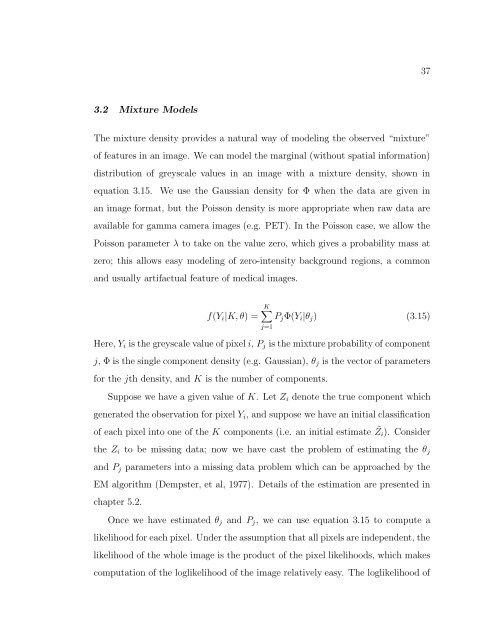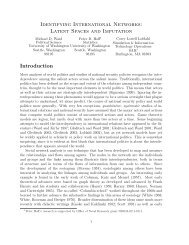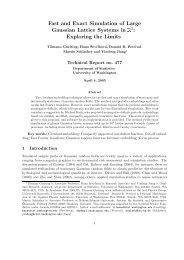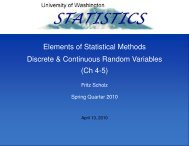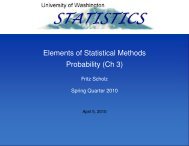View - Statistics - University of Washington
View - Statistics - University of Washington
View - Statistics - University of Washington
You also want an ePaper? Increase the reach of your titles
YUMPU automatically turns print PDFs into web optimized ePapers that Google loves.
373.2 Mixture ModelsThe mixture density provides a natural way <strong>of</strong> modeling the observed “mixture”<strong>of</strong> features in an image. We can model the marginal (without spatial information)distribution <strong>of</strong> greyscale values in an image with a mixture density, shown inequation 3.15. We use the Gaussian density for Φ when the data are given inan image format, but the Poisson density is more appropriate when raw data areavailable for gamma camera images (e.g. PET). In the Poisson case, we allow thePoisson parameter λ to take on the value zero, which gives a probability mass atzero; this allows easy modeling <strong>of</strong> zero-intensity background regions, a commonand usually artifactual feature <strong>of</strong> medical images.K∑f(Y i |K, θ) = P j Φ(Y i |θ j ) (3.15)j=1Here, Y i is the greyscale value <strong>of</strong> pixel i, P j is the mixture probability <strong>of</strong> componentj, Φ is the single component density (e.g. Gaussian), θ j is the vector <strong>of</strong> parametersfor the jth density, and K is the number <strong>of</strong> components.Suppose we have a given value <strong>of</strong> K. Let Z i denote the true component whichgenerated the observation for pixel Y i , and suppose we have an initial classification<strong>of</strong> each pixel into one <strong>of</strong> the K components (i.e. an initial estimate ˜Z i ). Considerthe Z i to be missing data; now we have cast the problem <strong>of</strong> estimating the θ jand P j parameters into a missing data problem which can be approached by theEM algorithm (Dempster, et al, 1977). Details <strong>of</strong> the estimation are presented inchapter 5.2.Once we have estimated θ j and P j , we can use equation 3.15 to compute alikelihood for each pixel. Under the assumption that all pixels are independent, thelikelihood <strong>of</strong> the whole image is the product <strong>of</strong> the pixel likelihoods, which makescomputation <strong>of</strong> the loglikelihood <strong>of</strong> the image relatively easy. The loglikelihood <strong>of</strong>


